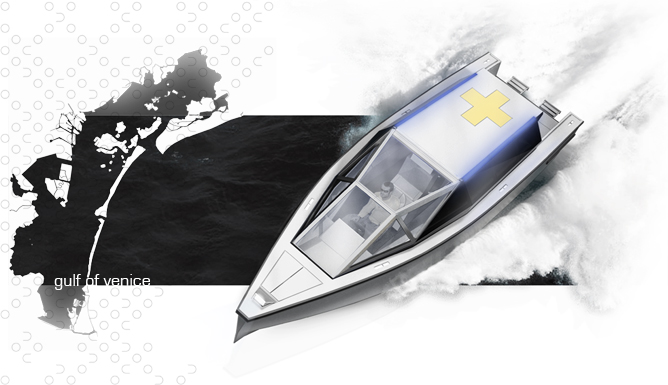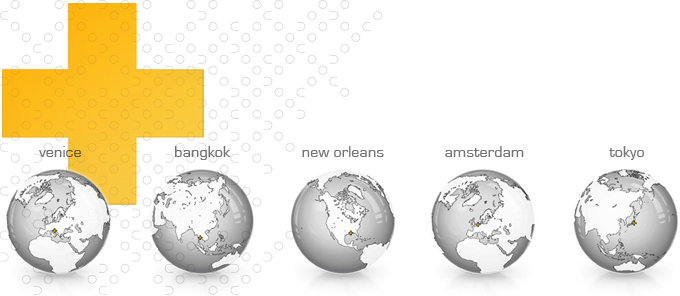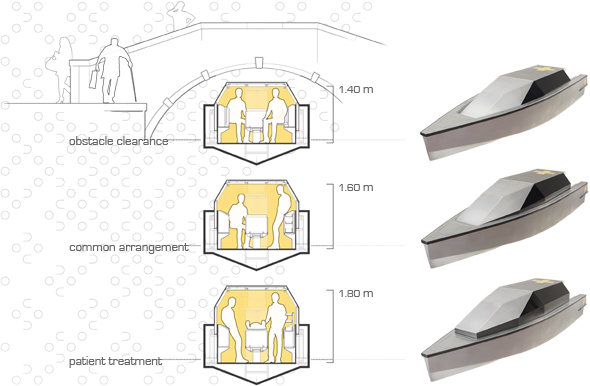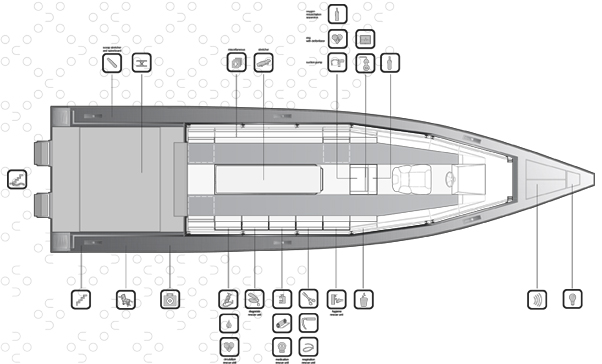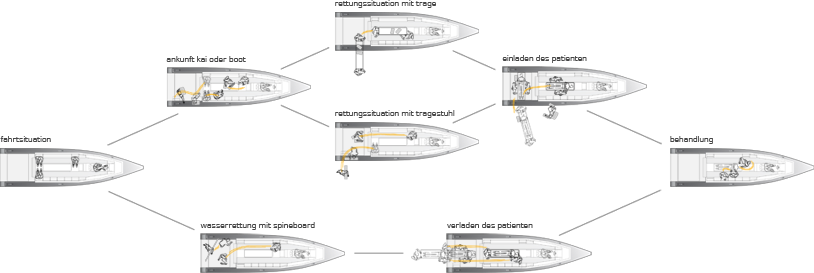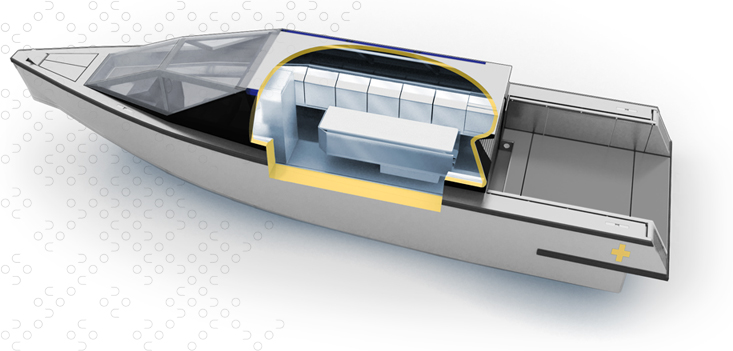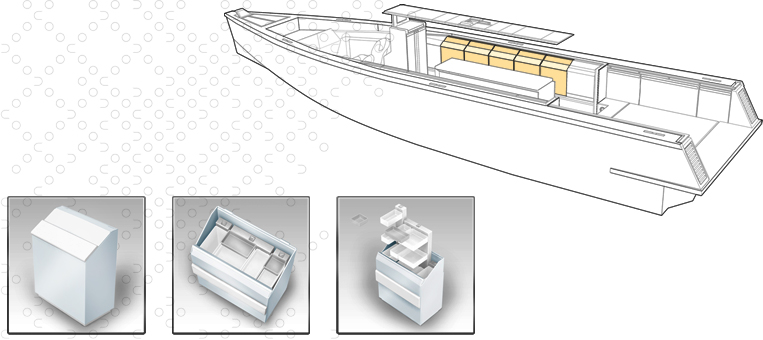Delfino – Mobile Medical Facility
Delfino – SparkAwards Finalist 2012
name of design : delfino – mobile medical facility
design by : OCO ODO + Mae Seetha Dauth
„Delfino“ is an emergency rescue boat for water cities, as a necessary precautionary addition to the fleet of emergency medical services in urban areas, in light of climate change and the damages caused by frequent natural disasters.
The rescue craft revolutionizes treatment on an aquatic mobile emergency unit, through a height adjustable cabin top and incorporation of careful ergonomics with highly efficient and considered detailing and precise zoning of storage and patient care space, whilst paying special attention to hygiene.
The simple and sleek design, with strategically placed medical crosses for identification, defines the external appearance, reinforcing stability, security and speed. The interior provides a positive and calming environment with copious natural lighting and concealed medical equipment optimizing the patient’s well-being.
1_BACKROUND:
„Delfino“ is an emergency rescue boat for water cities, as a necessary addition to the fleet of land-based and airborne emergency medical services in urban areas. Such precautions become a necessity in light of climate change and frequent natural disasters, whose damages often demonstrate constraints of urban infrastructure, leaving street and air traffic unusable for rescue missions.
Generally, medical boats are used for the rescue of persons on the open water near cities, and not for rescue in urban areas itself. The only exception is Venice (Italy) – the city on water.
To assure a comprehensive design of such a vessel for assignments in urban areas, the rescue boat “Delfino” was adapted to the challenging conditions of the water city, with input from the paramedics at the Venetian hospital „Ss. Giovanni e Paolo“.
Venice has special challenges for boat designers such as low bridges, narrow canals, sharp chop waves caused by passing crafts and water level discrepancies of up to one meter. There is the need to make in water rescues, as well as load and offload injured or disabled patients to and from a rolling boat or quayside. The rescue boats need to be suitable for driving in the canals, as well as on open sea.
2_EXTERNAL DESIGN:
A simple and sleek design reinforcing stability, security and speed, defines the external appearance of the boat.
A half planing hull provides a stable and smooth ride while maintaining agility and maximizing carrying capacity. A jet engine minimizes draught. The superstructure is made of a carbon frame to which black glass panels are glued to protect the patient’s privacy, illuminating the surgery with natural light. The external paint finish is a combination of light and dark metallic grey with strategic placement of a typically Venetian yellow rescue cross as the symbol of recognition on the roof and sides of the boat. The emergency lights form a continuous line at the edge of the roof and cabin’s sides.
We included a hydraulically controlled raising and lowering system for the cabin top and determined three heights based on detailed studies of the existing bridges and varying water levels due to the tides, hereby catering to the specific needs of Venice. Generally, the boat has a cabin height of 1.6m. At 1.8m it is at its maximum, thus allowing doctors and paramedics to treat the patient in a standing position whilst braced against the sides of the cabin interior. The cabin lowers to 1.4m to enable the boat to pass under low bridges. The paramedics must then work in a sitting position for the short time the boat is navigating the low bridges.
3_INTERIOR DESIGN:
The interior has the design goal of providing a positive and calming environment to ease stress for the patient. All equipment is concealed from the patient’s view within the cabin’s interior. Simple push/pull mechanisms are used to swing out the required elements. The importance of hygiene was a fundamental issue considered during the development and design process.
Through incorporation of careful ergonomics with highly efficient and considered detailing and precise zoning of storage and patient care space, a rescue craft is created that revolutionizes treatment on a mobile medical facility, within the space limitations dictated by a mobile emergency unit.
From stern to bow, the boat incorporates three areas which have been designed as one continuous space: the loading deck, the patient care area, and the navigation cockpit.
Access to “Delfino” is gained via the 2.5m long loading deck. A loading platform which can be raised and lowered, as well as extended horizontally is integrated into the deck to negotiate the height difference between the quay or intermediate boat and the rescue vessel. Additional manually extractable ship steps guarantee a quick alternative disembarkation possibility. Similar to the rescue equipment they are stored in a compartment which is integrated into the boat’s sides. For water rescue, two automatically retractable boat ladders with hydraulic control are concealed within the deck.
The rescue vessel seats up to five people in the cabin – the driver, two paramedics, a doctor and the patient. At the centre of the cabin is a height adjustable patient care surface with integrated removable stretcher, as is common in most ambulances today. A corridor on either side allows for movement of the paramedics and treatment of the patient.A fixed central console behind the stretcher houses critical medical instruments, control systems and displays within easy reach of the primary paramedic. The console is connected to the cabin roof with its concealed digital displays, medical light and brackets for tubes and cables offering the same functionalities as an immobile treatment room.
Further medical utensils are hidden within a continuous stretch of specially designed storage units at either cabin side. All cabin elements were raised from the deck to avoid contact with dirty water, while at the same time keeping them as low as possible to maximise the feeling of space and natural lighting. The interior cabin elements (except for mechanical controls) are made from powder coated aluminium to reduce weight. Carefully designed logos identify the content of the respective unit. A top operable cabinet allows for minimized cabin width whilst maintaining optimal organization. The cover is angled in the front portion with a strip of padded white leather for the stabilization of paramedics during treatment. It slides open and a push activated hydraulic lifting mechanism raises precisely organized compartments with stainless steel medical bowls of utensils. Five removable rescue units divided into hygiene, respiration, diagnosis, circulation, and medication respectively can be removed for restocking, cleaning and interchange with other medical boats.
Colour coding was used by demarcating unclean floor areas for movement in grey colour and all medical storage and treatment areas in carbon white, symbolizing cleanliness.

